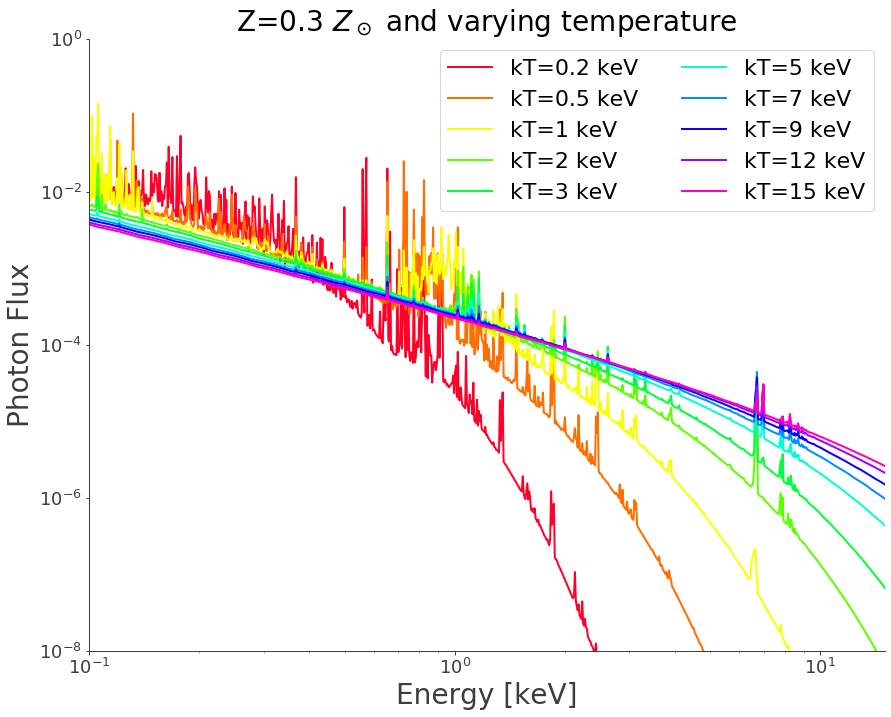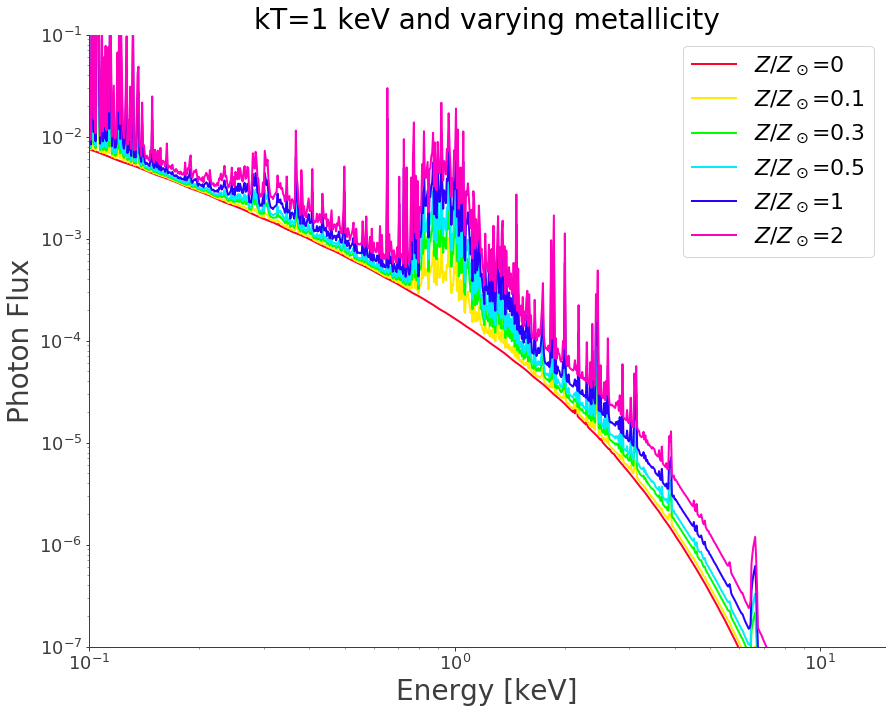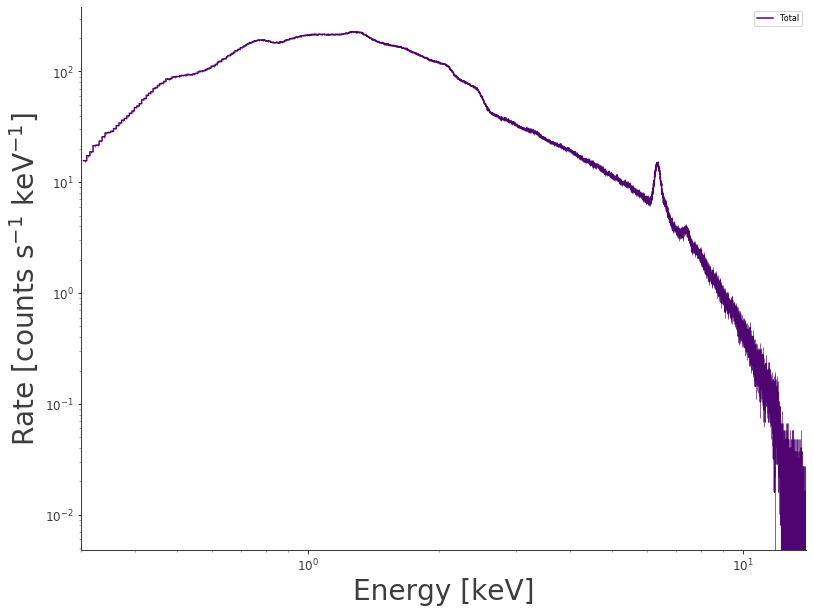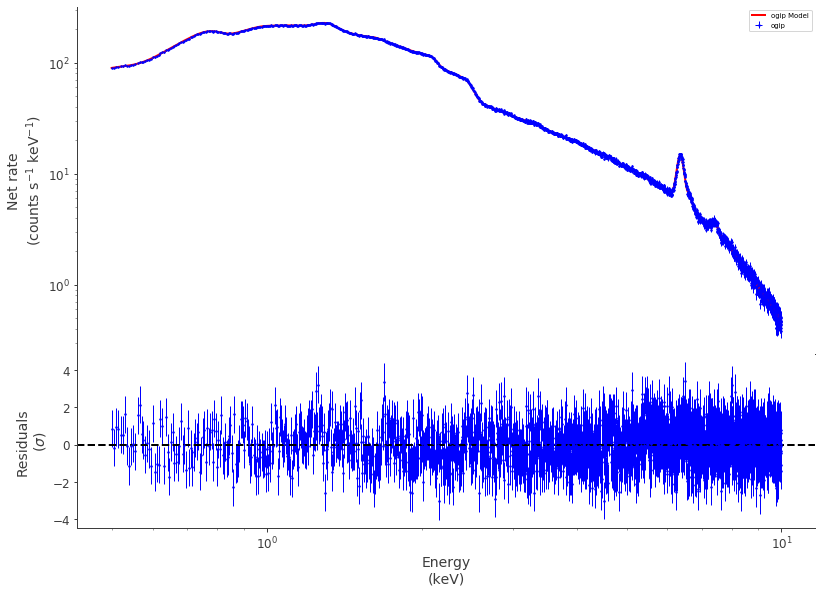Fitting XMM-Newton data with the APEC model
The Astrophysical Plasma Emission Code (APEC, Smith et al. 2001) is a state-of-the-art code to model the X-ray emission of optically thin astrophysical plasma in collisional equilibrium. APEC has been widely used in the literature to study the spectra of a wide variety of sources, such as galaxy clusters and groups, supernova remnants, or stellar coronae. The code self-consistently models the continuum (bremsstrahlung) emission as well as the pseudo-continuum and over 10,000 individual emission lines.
Astromodels includes a native Python implementation of APEC based on `pyatomdb <https://atomdb.readthedocs.io/en/master/>`__. As the model is only available when an installation of pyatomdb can be found, the user must make sure pyatomdb is installed and the required atomic data files have been downloaded.
Setting up pyatomdb
pyatomdb is easily installable using pip:
$] pip install pyatomdb
When running the code for the first time, the user will be requested to download the ATOMDB database locally
$] python -c "import pyatomdb"
This command will prompt the user to choose a directory to store the atomic data (usually $HOME/atomdb). Once the data have been downloaded, the ATOMDB environment variable must be set to indicate the location of the atomic data
$] export ATOMDB=$HOME/atomdb
OK, we’re all set!
Loading the APEC model
Once pyatomdb is properly installed, it is available as a “Function1D” object
[1]:
%%capture
from threeML import *
modapec = APEC()
The intensity of the various lines in the model is set relative to the Solar abundance. Therefore, one must set the Solar abundance table to predict the line intensity, using the init_session method of the APEC class. By default, i.e. if the init_session method is ran with no argument, the code defaults to Anders & Grevesse (1989).
[2]:
modapec.init_session(abund_table="AG89")
Will not thermally broaden lines
If, for instance, we wish to initialize the APEC model to use the Lodders & Palme (2009) table, we pass
modapec.init_session(abund_table='Lodd09')
[3]:
modapec.display()
- description: The Astrophysical Plasma Emission Code (APEC, Smith et al. 2001) contributed by Dominique Eckert
- formula: $n.a.$
- parameters:
- K:
- value: 1.0
- desc: Normalization in units of 1e-14/(4*pi*(1+z)^2*dA*2)*EM
- min_value: 1e-30
- max_value: 1000.0
- unit:
- is_normalization: True
- delta: 0.1
- free: True
- kT:
- value: 1.0
- desc: Plasma temperature
- min_value: 0.08
- max_value: 64.0
- unit:
- is_normalization: False
- delta: 0.1
- free: True
- abund:
- value: 1.0
- desc: Metal abundance
- min_value: 0.0
- max_value: 5.0
- unit:
- is_normalization: False
- delta: 0.01
- free: False
- redshift:
- value: 0.1
- desc: Source redshift
- min_value: 0.0
- max_value: 10.0
- unit:
- is_normalization: False
- delta: 0.001
- free: False
- K:
The parameters of the model are set in the following way
[4]:
modapec.kT.value = 3.0 # 3 keV temperature
modapec.K.value = 1e-3 # Normalization, proportional to emission measure
modapec.redshift.value = 0.0 # Source redshift
modapec.abund.value = (
0.3 # The metal abundance of each element is set to 0.3 times the Solar abundance
)
Now let’s see how the model depends on the input temperature…
[5]:
import numpy as np
energies = np.logspace(-1.0, 1.5, 1000) # Set up the energy grid
ktgrid = [0.2, 0.5, 1.0, 2.0, 3.0, 5.0, 7.0, 9.0, 12.0, 15.0] # Temperature grid
[6]:
import matplotlib.pyplot as plt
import matplotlib.colors as colors
import matplotlib.cm as cmx
%matplotlib inline
plt.clf()
fig = plt.figure(figsize=(13, 10))
ax = fig.add_axes([0.12, 0.12, 0.85, 0.85])
for item in ax.get_xticklabels() + ax.get_yticklabels():
item.set_fontsize(18)
nspec = len(ktgrid)
values = range(nspec)
cm = plt.get_cmap("gist_rainbow")
cNorm = colors.Normalize(vmin=0, vmax=values[-1])
scalarMap = cmx.ScalarMappable(norm=cNorm, cmap=cm)
ccc = []
for i in range(nspec):
ccc.append(scalarMap.to_rgba(i))
for i in range(nspec):
modapec.kT.value = ktgrid[i]
plt.plot(energies, modapec(energies), color=ccc[i], label="kT=%g keV" % (ktgrid[i]))
plt.xscale("log")
plt.yscale("log")
plt.xlabel("Energy [keV]", fontsize=28)
plt.ylabel("Photon Flux", fontsize=28)
plt.axis([0.1, 15.0, 1e-8, 1.0])
plt.title("Z=0.3 $Z_\odot$ and varying temperature", fontsize=28)
plt.legend(fontsize=22, ncol=2)
[6]:
<matplotlib.legend.Legend at 0x7f4927f66940>
<Figure size 432x288 with 0 Axes>

Now let’s see how the model depends on metallicity for a temperature of 1 keV…
[7]:
Zgrid = [0.0, 0.1, 0.3, 0.5, 1.0, 2.0] # Metallicities wrt Solar
modapec.kT.value = 1.0
[8]:
plt.clf()
fig = plt.figure(figsize=(13, 10))
ax = fig.add_axes([0.12, 0.12, 0.85, 0.85])
for item in ax.get_xticklabels() + ax.get_yticklabels():
item.set_fontsize(18)
nspec = len(Zgrid)
values = range(nspec)
cm = plt.get_cmap("gist_rainbow")
cNorm = colors.Normalize(vmin=0, vmax=values[-1])
scalarMap = cmx.ScalarMappable(norm=cNorm, cmap=cm)
ccc = []
for i in range(nspec):
ccc.append(scalarMap.to_rgba(i))
for i in range(nspec):
modapec.abund.value = Zgrid[i]
plt.plot(
energies, modapec(energies), color=ccc[i], label="$Z/Z_\odot$=%g" % (Zgrid[i])
)
plt.xscale("log")
plt.yscale("log")
plt.xlabel("Energy [keV]", fontsize=28)
plt.ylabel("Photon Flux", fontsize=28)
plt.axis([0.1, 15.0, 1e-7, 0.1])
plt.title("kT=1 keV and varying metallicity", fontsize=28)
plt.legend(fontsize=22)
[8]:
<matplotlib.legend.Legend at 0x7f494f7edee0>
<Figure size 432x288 with 0 Axes>

Comparison with XSPEC
To test the implementation, let’s simulate a spectrum with XSPEC and fit it within 3ML using the APEC model. We simulate an XMM-Newton/EPIC-pn spectrum with a temperature of 5 keV, a metallicity of 0.3 Solar, a normalization of unity and a redshift of 0.1. The simulated model is absorbed by photo-electric absorption (PhAbs model) with a column density of \(10^{21}\) cm\(^{-2}\). We start by declaring the model,
[9]:
phabs = PhAbs()
phabs.NH.value = 0.1 # A value of 1 corresponds to 1e22 cm-2
phabs.NH.fix = True # NH is fixed
phabs.init_xsect(abund_table="AG89")
modapec.kT = 3.0 # Initial values
modapec.K = 0.1
modapec.redshift = 0.1
modapec.abund = 0.3
mod_comb = phabs * modapec
Now we load the simulated spectrum in 3ML…
[10]:
xmm_pha = get_path_of_data_file("datasets/xmm/pnS004-A2443_reg2.fak")
xmm_rmf = get_path_of_data_file("datasets/xmm/pnS004-A2443_reg2.rmf")
xmm_arf = get_path_of_data_file("datasets/xmm/pnS004-A2443_reg2.arf")
ogip = OGIPLike("ogip", observation=xmm_pha, response=xmm_rmf, arf_file=xmm_arf)
pts = PointSource("mysource", 0, 0, spectral_shape=mod_comb)
Let’s have a look at the loaded spectrum…
[11]:
fig = ogip.view_count_spectrum()
fig.set_size_inches(13, 10)
ax = fig.get_axes()[0]
ax.set_xlim(left=0.3, right=14.0)
ax.set_xlabel("Energy [keV]", fontsize=28)
ax.set_ylabel("Rate [counts s$^{-1}$ keV$^{-1}$]", fontsize=28)

Here we set up the likelihood and fit the data
[12]:
ogip.remove_rebinning()
ogip.set_active_measurements("0.5-10.")
ogip.rebin_on_source(20)
model = Model(pts)
jl = JointLikelihood(model, DataList(ogip))
result = jl.fit()
Best fit values:
| result | unit | |
|---|---|---|
| parameter | ||
| mysource.spectrum.main.composite.K_2 | (9.8742 +/- 0.0033) x 10^-1 | 1 / (cm2 keV s) |
| mysource.spectrum.main.composite.kT_2 | 5.019 +/- 0.005 | keV |
Correlation matrix:
| 1.00 | -0.30 |
| -0.30 | 1.00 |
Values of -log(likelihood) at the minimum:
| -log(likelihood) | |
|---|---|
| ogip | 9682.695868 |
| total | 9682.695868 |
Values of statistical measures:
| statistical measures | |
|---|---|
| AIC | 19369.398043 |
| BIC | 19380.497261 |
The fitted values are within 1% of the input ones from XSPEC, showing that the native 3ML implementation is accurate. We can visualize the fit in the following way
[13]:
fig = display_spectrum_model_counts(
jl, data_color="blue", model_color="red", min_rate=5e-4
)
fig.set_size_inches(13, 10)
